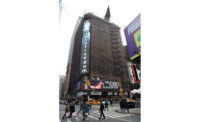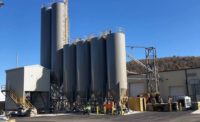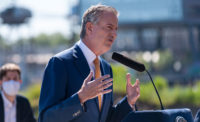New York City's Facade Inspection and Safety Program, or Local Law 11, now carries more stringent punishment for owners of buildings whose facades fail to meet safety regulations.
Changes to the law took effect Feb. 20, enacted after an architect was killed in December by falling debris from a Manhattan building. They include new penalties as well as more robust inspection mandates and documentation.
Sara Director, a partner at law firm Barasch McGarry, warns that "building owners need to comply with the new rules or risk fines, damages in civil litigation from individuals injured or killed by the building façade, and even criminal penalties."
The latter could happen under an already existing law if an owner is charged with violating the city's administrative code, which carries maximum penalties of a $25,000 fine and one year of imprisonment.
In a client advisory that Hoffman Architects Inc. issued ahead of the changes taking effect, the firm notes the following, says its communications manager, Alison Hoffman:
- Failing to file an acceptable inspection report now can generate a civil fine of $5,000, a fivefold increase.
- Owners who file late incur a penalty of $1,000 per month, four times the previous monthly fine.
- Owners who fail to correct unsafe conditions are liable for a $1,000-per-month penalty, plus a monthly fine for each linear foot of sidewalk shed, starting at $10 per linear ft of shed per month after the first year, and increasing each year thereafter, up to $40 per linear ft.
- Failing to correct a "safe with a repair and maintenance program," or SWARMP, condition from the previous "cycle" of the law, so that it now must be filed as unsafe under the new rules, carries a penalty of $2,000.
The New York City Dept. of Buildings did not wait for the amendments, however, before taking stronger measures against noncompliance.
In January, it began issuing emergency declarations demanding that owners fix dangerous building facades, allowing the city to send its own contractors to erect scaffolding—and to send the bill to the property owner.
Still, the changes offer new burdens for noncompliant owners.
"The amended rules will definitely cause additional expenses to owners of affected buildings," says Frank Scanlon, a CTA Architects associate. "There are additional scaffold drops required, possible probes dependent on wall type which may require filing, etc. Fines and penalties are greatly increased, and there are several new categories."
One major change, Scanlon says, is the new requirement for close-up physical scaffold examinations of exterior walls, which owners or their representatives must now conduct at intervals of 60 ft along the length of a structure.
Drones, high-resolution photographs or other methods of assessing exterior wall conditions cannot be used in place of close-up inspections.
Director points out that there are also additional requirements related to experience and responsibilities of qualified exterior wall inspectors, who must be able to spot potentially dangerous faade conditions.
Hoffman says that "the real impact on building owners comes with the more demanding inspection requirements."
Indeed, while the penalties have made the biggest headlines, Director argues that the fines are "insufficient" for deep-pocketed owners in the city.
"The fines need to be so severe that the building owners lose sleep over the prospect of their bank accounts being drained should they fail to timely comply with the law," the attorney says.
Scanlon, however, credits the modified Local Law 11's balancing act.
"Rules and laws could always go further," the architect says. "However, there is a balance of what can be done practically in a city with tens of thousands of buildings, all requiring inspection, and a limited pool of qualified inspectors and contractors who can provide the required rigging or other access, within the prescribed timeframes and deadlines."






Post a comment to this article
Report Abusive Comment